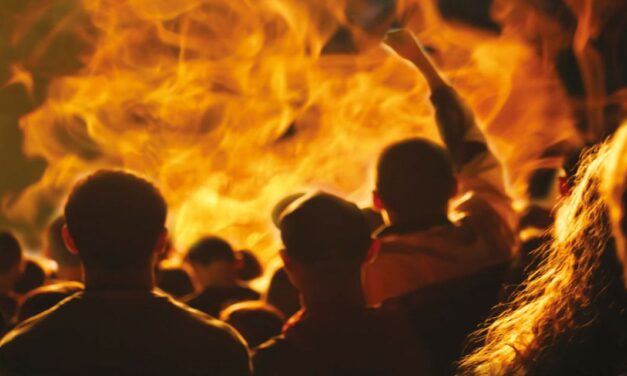This book review first appeared in the Christian Research Journal, volume 12, number 3 (Winter/Spring 1990). For more information about the Christian Research Journal, click here.
A Summary Critique of
This Present Darkness
Frank Peretti
(Crossway, 1986)
This Present Darkness is a novel about how a few Christians fight for the soul of a small town named Ashton that is being taken over by a conspiratorial form of the New Age movement. Author Frank Peretti expands the reader’s perspective of the fight beyond just the human level to the spiritual — where demons influence humans and battle angels. This expansion is Peretti’s imaginative interpretation of what Paul might have had in mind when he wrote Ephesians 6:12, “For we are not contending against flesh and blood, but against the principalities, against the powers, against the world rulers of this present darkness, against the spiritual hosts of wickedness in the heavenly places” (RSV).
Peretti’s book has become a commercial success, selling more than 1,122,000 copies. Since 1988 This Present Darkness has been at the top of the best seller list of the Evangelical Christian Publishers Association. (At press time, it is listed as the number one best-selling religious paperback.) There has been talk, moreover, of making the book into a motion picture. Plus, a sequel entitled Piercing the Darkness has been published and presently occupies the number two position on the best seller list.
I especially appreciate three things about This Present Darkness. First, it is fascinating reading. Once one begins the book, it’s hard to put down.
Second, it spurs the reader on to prayer, which was apparently one of Peretti’s primary purposes for writing the book. In an interview with Charisma magazine, he said that “whether people like it or not, there is a spiritual war going on. The main thrust of my book is encouraging believers to engage in intercessory prayer and to open their eyes to spiritual realities.” (Dan O’Neill, “The Supernatural World of Frank Peretti,” Charisma and Christian Life, May 1989, 48, 50.)
Third, Peretti has portrayed the work of the pastor in a tremendously positive light. Considering that Peretti is himself an Assemblies of God pastor, this is understandable. Nevertheless, in light of the raw deal the secular media usually gives the pastor, reading Peretti’s rendition is refreshing.
Besides these notes of appreciation, I want to sound three cautionary notes. First, Peretti portrays the New Age movement as a conspiratorial movement. Dan O’Neill, who interviewed Peretti, commented that “Peretti is the first to admit that some Christians have a morbid preoccupation with New Age conspiracies” (p. 52). But “a morbid preoccupation with New Age conspiracies” is precisely the kind of response Peretti encourages in his book. While one subplot in the novel does involve an individual (Sandy) being entangled by the philosophical web of the New Age, the main plot has to do with the inexorable movement of the New Age juggernaut as it rolls over the town. New Agers have, for example, taken over Ashton’s grocery store, the police department, the courthouse, and a liberal church; they are in the process of taking over the Bible-preaching church, the newspaper, and the local college.
There is a place for understanding how the New Age movement has influenced and infiltrated our society. But some Christians have become so preoccupied with labeling that which is New Age in our culture that they have pushed aside the biblical mandate to evangelize the lost — which includes the New Ager. Such Christians have created a we/they mentality which works against seeing the New Ager as someone seeking spiritual truth and needing to hear the gospel. It is precisely this kind of we/they mentality that Peretti’s book fosters. New Agers are portrayed as so totally surrendered to demonic control that they appear beyond God’s reach.
My second caution has to do with Peretti’s portrayal of the purpose of prayer. One gets the impression in This Present Darkness that the primary purpose of prayer is to give power to angels. For example, toward the beginning of the book, Tal — the leader of the good angels — refuses to fight the demons, knowing that the “prayer cover” of the Christians is insufficient (pp. 148-49). For a book billed as being anti-New Age, such a concept of prayer — in which it somehow supplies power to the angels — is amazingly “New Ageish.” Prayer as interpersonal communion with God, on the other hand, is sorely missing.
Third, Peretti verges on giving too much power to demons in their ability to influence people’s thoughts and actions. In his interview, Peretti “cautions against finding a demon ‘under every bush,'” and of “blaming everything on demons” (p. 52). Once again, though, what Peretti says and the response his book encourages are two different things. For example, Peretti pictures the newspaper editor, Marshall Hogan — who is despondent over being rejected by his daughter — as having the demon named Complacency digging its “taloned fingers” into his leg to encourage his despondency (pp. 39-40). According to Peretti, demons even have the power to cause cars to malfunction (p. 138). (Now that I can believe!) Such demonization, moreover, is a major theme in the book. The factor of humanity’s inclination toward sin (a major theme of Scripture) isn’t given much consideration until page 312 out of a 376-page book.
Literary license gives Peretti the right to emphasize demonic influence in order to open our eyes to such a reality. But he does so almost to the point of disregarding individual responsibility for sinful acts. Peretti’s book has given a shot in the arm to those who do find a demon under every bush and who jump to the remedy of exorcism for every spiritual malady.
In all fairness, though, I must also say that while Peretti might have overemphasized the power of demons, he has not gone beyond biblical bounds — that is, he doesn’t give them the power to coerce people to act against their wills. The Bible, too, says demons can influence our thoughts (cf. Eph. 2:2; 6:10,16) — but not to the point of coercion. Demons are able only to tempt and encourage us along the path to which we are already inclined because of our sinful nature.
All in all, Peretti is more successful in awakening the reader to the possible workings of the spiritual realm than in encouraging and equipping the Christian to expose those caught in the darkness of the New Age movement to the light of the gospel.








